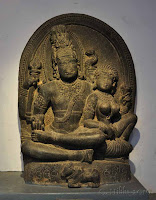 Madurai, M.K. Gandhi made his decision to only wear khadi, Indian-made cloth. I wanted to buy some clothing made from khadi, but apparently the only things made from this cloth are lungis, which are um... pieces of cloth.
Madurai, M.K. Gandhi made his decision to only wear khadi, Indian-made cloth. I wanted to buy some clothing made from khadi, but apparently the only things made from this cloth are lungis, which are um... pieces of cloth.
The temple in Madurai was amazing, but it's difficult to depict it here. When I was standing in front of the temple, looking at all the unique colourful statues on the towers was fascinating; looking at my photos all the statues start to look the same.
 Inside, the temple had fascinating paintings on the ceiling, again every one unique, and it was filled with stone statues. Sadly, non-Hindus are not allowed to take the goddess's darshan.
Inside, the temple had fascinating paintings on the ceiling, again every one unique, and it was filled with stone statues. Sadly, non-Hindus are not allowed to take the goddess's darshan.I also slept much more than I thought necessary in Madurai.

Kanyakumari is the southernmost point of India! It is the point where the Bay of Bengal to the east, the Indian Ocean to the south, and the Arabian Sea to the west, all meet. It is also the closest to the equator I have ever been: 8 degrees north latitude. I met Alex on the train, a Chinese guy working in Delhi, and we spent the day talking about our experiences living as foreigners in India.
The town is named for Kanyakumari, the virgin goddess who won a battle against the demon. Her temple is lovely inside, as is the goddess, but photos are not allowed inside, and the outside is generic.

This photo is on the ferry to the Swami Vivekananda Rock memorial, where Vivekananda apparently meditated for three days before developing his Hindu reform philosophies. Beside Alex is a young man who told me about the truth as taught by Vivekananda, set off my proselytizer alarms, and eventually bought me a book. Beside that island is a huge statue of Tiruvalluvar, who makes his second appearance in my trip.
 I visited the Gandhi memorial, where his ashes were exhibited before being scattered in the sea. Important photos from his life are reproduced on the walls, but otherwise it's uninspiring. The Vivekananda museum was closed for renovations, a disappointing but benign side-effect of the monsoon season.
I visited the Gandhi memorial, where his ashes were exhibited before being scattered in the sea. Important photos from his life are reproduced on the walls, but otherwise it's uninspiring. The Vivekananda museum was closed for renovations, a disappointing but benign side-effect of the monsoon season.The day I visited, the waves were incredibly powerful, and I watched for a long time from the observation tower.

I also discovered that sleeping so much was an omen of the terrible head cold to come, which marks my 6th (or is it 7th now?) cold or illness since arriving in India.




























